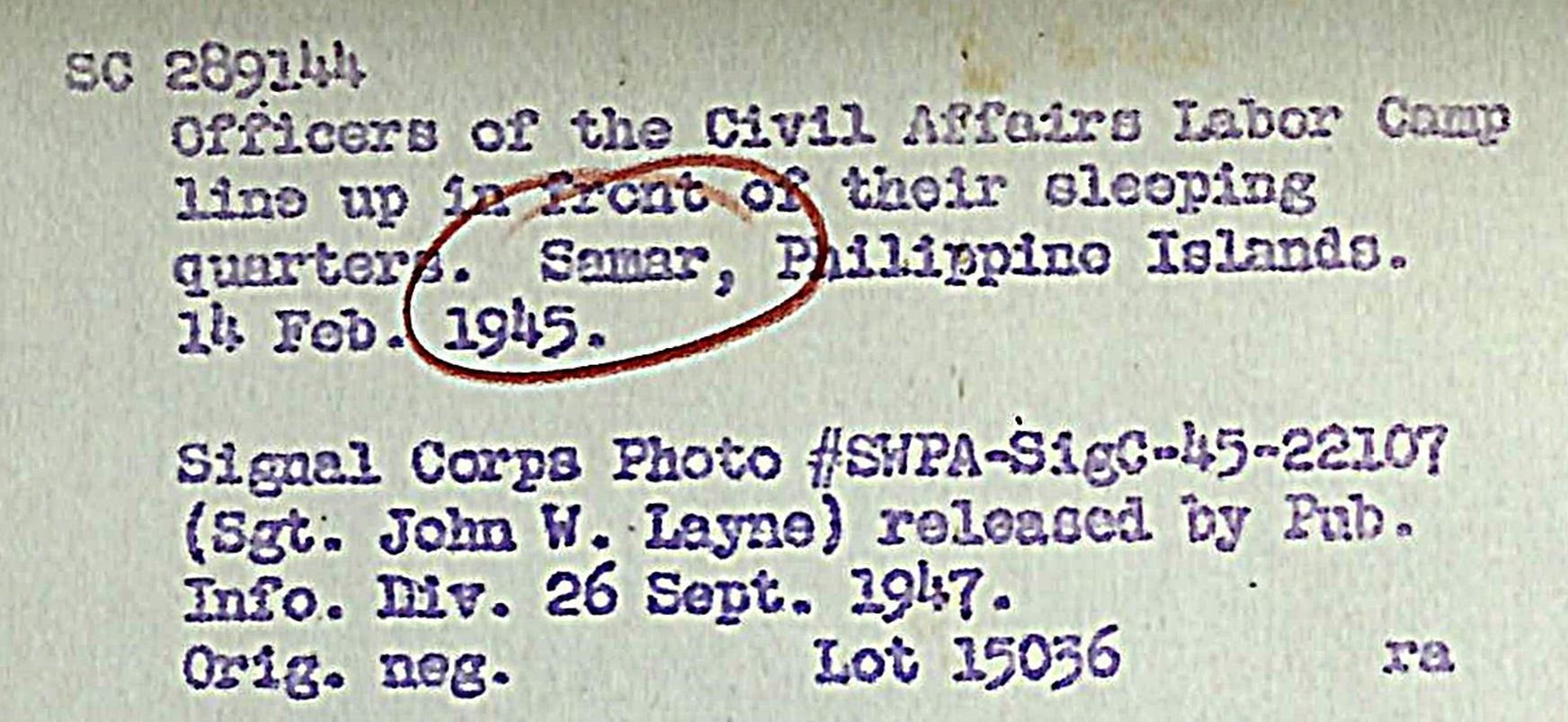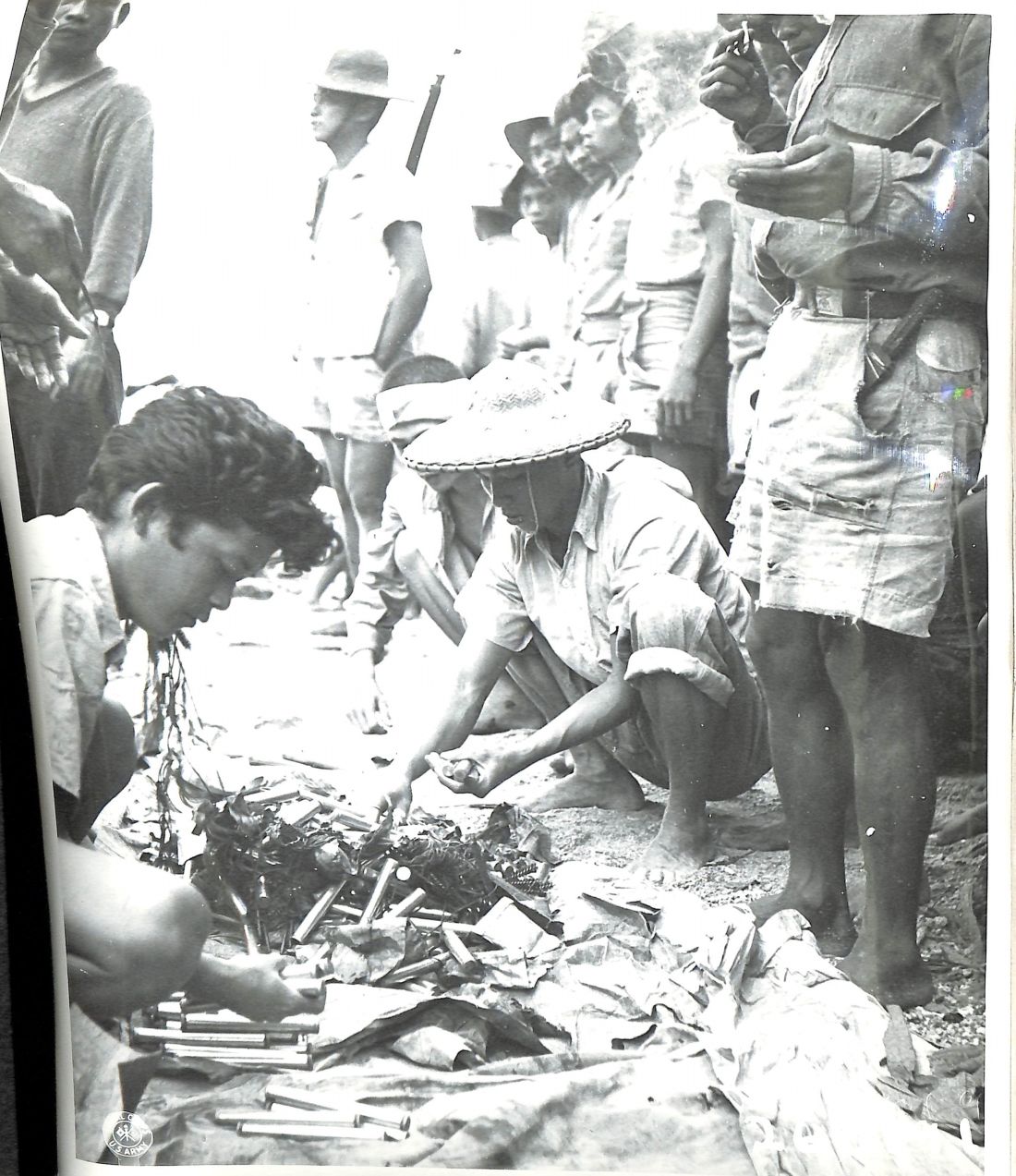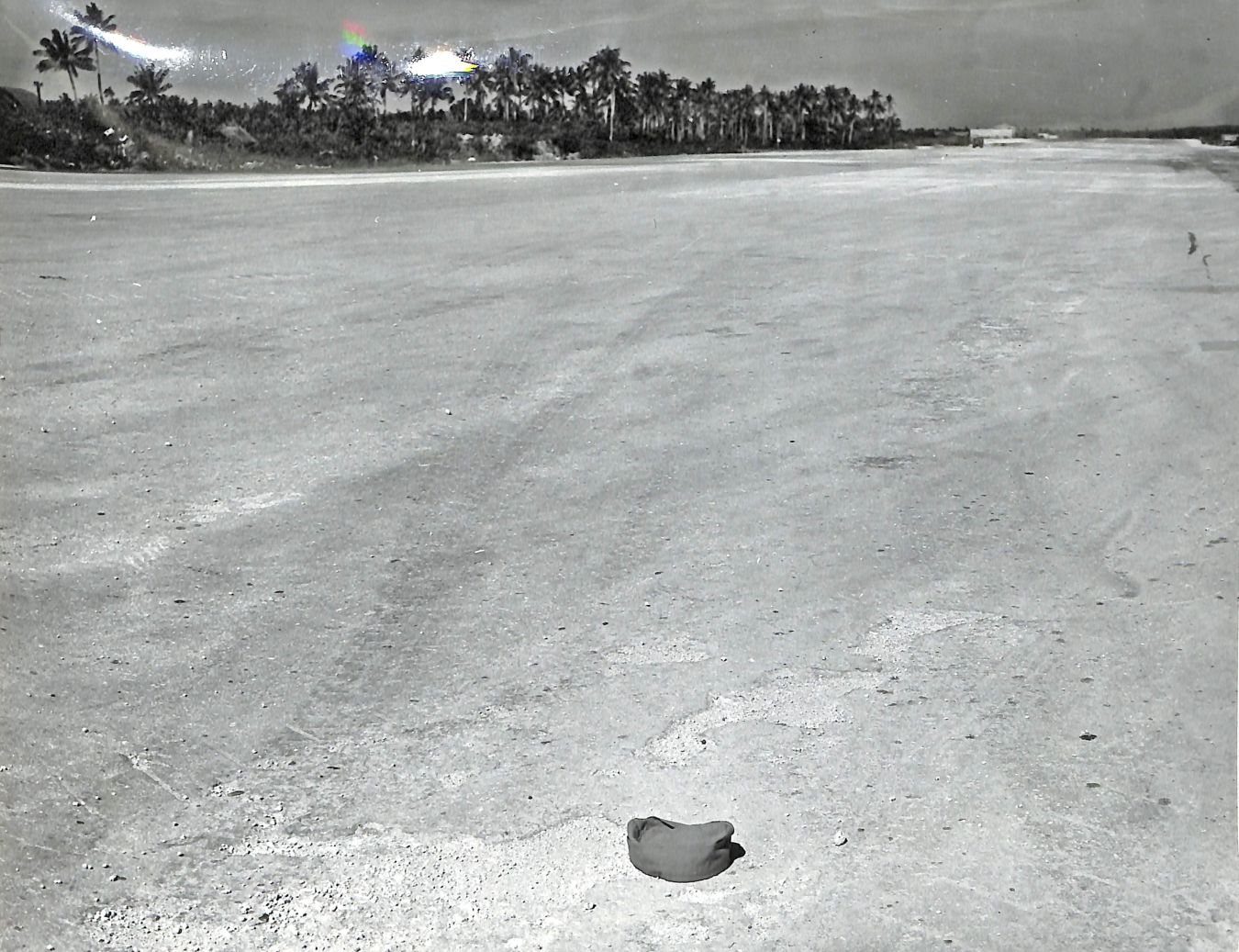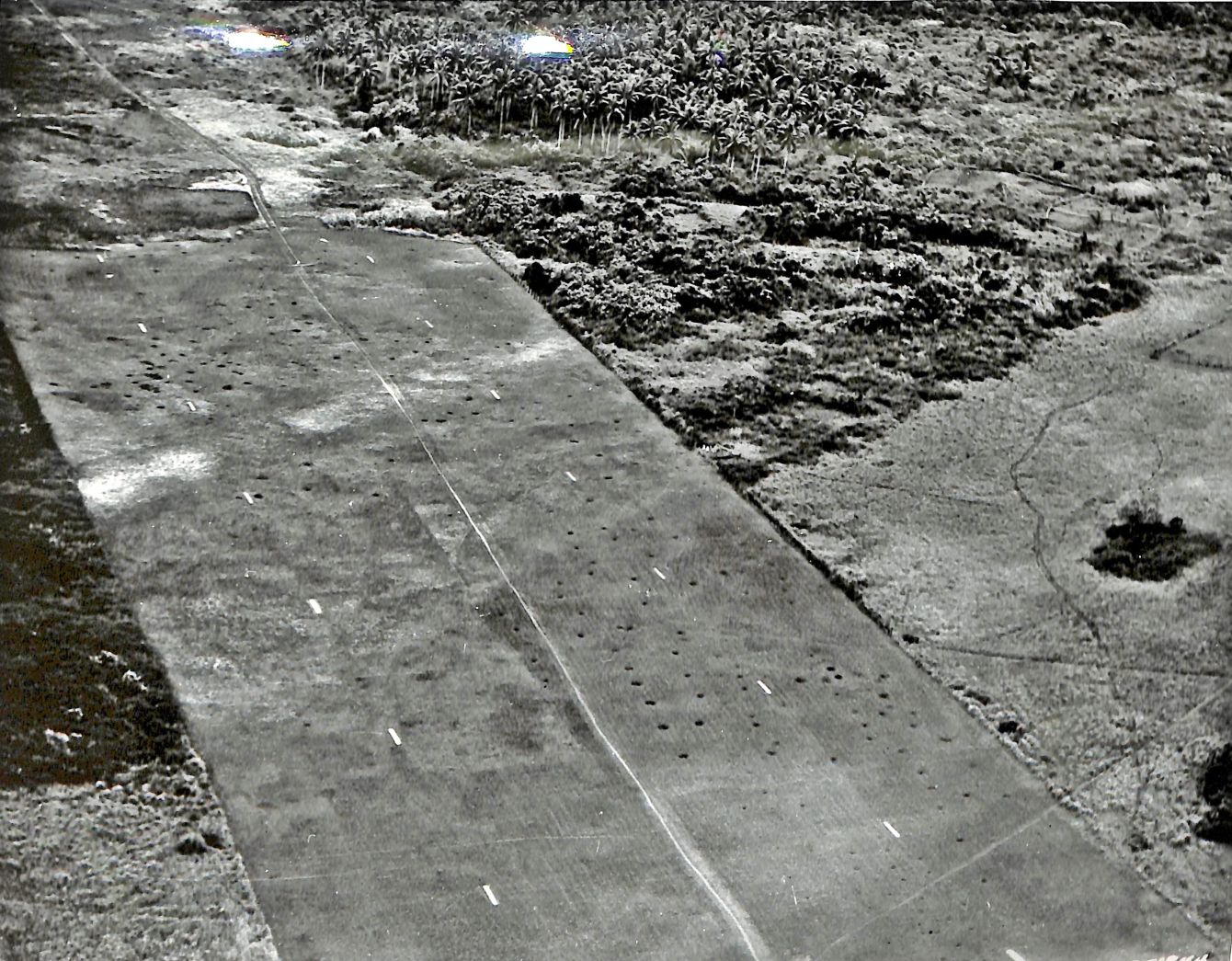
Zf652. -01. Guinuan Field, NARA, 111-SCA-Album_2987_50. This was a huge airfield, built by the Seabees, used by all. The Bells of Balangiga and President Duterte landed here when the bells returned in Dec. 2018.
—————————————————–
Samar is another interesting place in this world and it is accessible to me; it is full of Philippine and US History. This album is about WWII in Samar. I started to post this material here in Flickr because it allows one to post in high resolution. The NARA source is: Click here: Comprehensive History of Navy Bases in the Philippines during WWII: click here:
———————————————————-

Zf653. – 02. Guinuan Field, NARA, 111-SCA-Album_2987_51. This is the NARA description of the previous image!

Zf654. -03. Guinuan 1945, NARA, 111-SCA-Album_2987_52. Read the history of the link in the album description! This was part of a huge Naval Facility at the south east corner of Samar. In Aug. 1945 there were about 60, 000 sailors here. This was maybe the Naval Station section. The bridge leads to the island of Tubabao, there was the Naval Receiving Station with several thousand Sailors coming or going to or from commands. In 1949 the White Russian Refugees from Red China were quartered here for several years. North of here was a huge PT Boat Base with hundreds of boats, after the war the engines were salvaged but the boats were burned. West of here was the Manicani Island which was used for a large ships repair base with 3 dry docks. Just east of here was the huge Guiuan Air Field, described and shown in picture #1. South of here was a huge Naval Supply Base with piers and meant Quonset buildings for storage. The town of Guiuan is maintaining a Naval Base Veterans Parks there today. Further up the coast, south Samar coast, were fuel and water points for the ships plus recreation beaches that could handle thousands of sailors in morning and afternoon shifts to consume grilled foods etc and rations of beer.

Zf655. – 04. Guinuan description, 111-SCA-Album_2987_53. This is the description for the previous image but NARA got it wrong. Read what I road at the previous picture.

Zf656. – 05. Smith & Smith, 111-SCA-Album_2987_26. Look for the description for this picture in the next image. Today we have Corregidor forum members who are descendents of the guerrillas who were active in Samar. Read this: click here:

Zf657. – 06. Smith & Smith, 111-SCA-Album_2987_27. This is the description of the previous image.

Zf658. – 07. Smith, 111-SCA-Album_2987_26. Look for the description for this picture in the previous image. Today we have Corregidor forum members who are descendents of the guerrillas who were active in Samar. Read this: click here:
————————————————————————————-
Samar, WWII, US Military, Guerillas from NARA
Five more images from NARA about the guerrillas and the Military Civil Affairs Labor Camp on Samar.
Samar is another interesting place in this world and it is accessible to me; it is full of Philippine and US History. This album is about WWII on Samar. The NARA source is, click here:
Comprehensive History of Navy Bases in the Philippines during WWII, click here:
These pictures and material are also posted in my Flickr account because it allows one to post in high resolution. This is the URL, click here!

Zf780. 08. Officers of the Civil Affairs Labor Camp in Samar on the 14th Feb. 1945. The picture is from NARA.

Zf781. 09. This is the NARA description for the previous image.

Zf782. 10. The Civil Affairs Labor Camp in Samar on the 14th Feb. 1945. The picture is from NARA.

Zf783, 11. This is the NARA description for the previous image.

Zf784. 12. Guerrillas load up ammunition supplies in Samar brought in from Leyte on the 15th Nov. 1944. The picture is from NARA.

Zf785. 13. This is the NARA description for the previous image.

Zf786. 14. Guerrillas check and sort supplies in Samar brought in from Leyte on the 15th Nov. 1944. The picture is from NARA.

Zf787. 15. This is the NARA description for the previous image.

Zf788. 16. Ignacio Claro is a typical guerrilla with a band on the island of Samar on the 15th Nov. 1944. The picture is from NARA.

Zf789. 17. This is the NARA description for the previous image.
==================================================
Samar, WWII, US Military, Guiuan Air Base
These pictures were generated by the Chief Engineers Office of the Armed Forces Western Pacific Area in June and July 1946 for a survey of airports in the Philippines.
Samar is another interesting place in this world and it is accessible to me; it is full of Philippine and US History. This album is about post WWII Guiuan Airfield in Samar. The pictures are from this NARA source, click here:
This is the comprehensive History of Navy Bases in the Philippines during WWII, Chapter XXIX
Bases in the Philippines, click here:
Here are paragraphs from the above URL of the Navy building bases:
Guiuan. — A survey party of 4 officers and 100 men arrived at Guiuan on November 30 to lay out the site for the bomber field. Detachments of the 61st and 93rd Battalions landed on the next day, and earth moving was started a week later. All work was maintained on a 24-hour basis; 780 operators and gradesmen were assigned to the strip and 184 to equipment maintenance. The first landings by heavy planes were made on December 22, just 14 days after the start of construction. The men produced 7,000 feet of 100-foot strip with 50-foot shoulders, five alert areas, 5,000 feet of taxiways, and 50 hardstands, requiring the movement of more than 344,000 yards of muck and coral.
On December 31, the first fighter squadron was ordered to the field. Surfacing of the strip with yellow coral was finished on January 15, 1945, and on the next day the first bomber squadron arrived. After its completion, the strip was used principally by Liberators of the 5th and 13th Air Forces.
Facilities were provided for overhaul and repair; gasoline storage (15,000 barrels) and administration buildings were included. Constructed for the aviation-supply depot and auxiliary repair and overhaul facilities were housing and messing facilities for 2,000 men. Construction on the air strip was carried on in the face of heavy rain and frequent night air alerts that delayed progress considerably.
Work on the second 7,000-foot strip was suspended after 2,000 feet had been completed, but was resumed in May. Excessive coral formations made excavation difficult and required a great deal of blasting. Equipment on this job required an abnormally amount of maintenance and repair. The major accomplishment on the project was excavation through a coral hill for 200 feet which required a maximum cut of approximately 26 feet. Practically every yard of the hill was solid coral, and shovels could remove only that which was blasted loose. Extensive hardstands, taxiways, and parking aprons completed the field installations.
I started to post this material in my Flickr account because it allows one to post in high resolution; this is the URL, click here.

Zf790. 18. Parking area 1946 at the former WWII Guiuan Naval Air Station, Air Base in East Samar, Philippines. This picture is from NARA.

Zf791. 19. This is the description of the previous NARA image.

Zf792. 20. This is the condition of the taxi way, 1946, at the former WWII Guiuan Naval Air Station, Air Base in East Samar, Philippines. This picture is from NARA.

Zf793. 21. This is the description of the previous NARA image.

Zf794. 22. This is the condition of the strip, 1946, at the former WWII Guiuan Naval Air Station, Air Base in East Samar, Philippines. This picture is from NARA.

Zf795. 23. This is the description of the previous NARA image.

Zf796. 24. Aerial view of the strip, 1946, at the former WWII Guiuan Naval Air Station, Air Base in East Samar, Philippines. This picture is from NARA.

Zf797. 25. This is the description of the previous NARA image.

Zf798. 26. Aerial view of the strip, 1946, at the former WWII Guiuan Naval Air Station, Air Base in East Samar, Philippines. This picture is from NARA.

Zf799. 27. This is the description of the previous NARA image.

Zf800. 28. Aerial view of the strip, 1946, at the former WWII Guiuan Naval Air Station, Air Base in East Samar, Philippines. This picture is from NARA.

Zf801. 29. This is the description of the previous NARA image.

Zf802. 30. Aerial view of the area, 1946, west of the former WWII Guiuan Naval Air Station, Air Base in East Samar, Philippines. This picture is from NARA. This was the heart of the Navy establishment; this area became the Guiuan Town of today. That bridge went to an island (bridge is destroyed now, weather) which was used as the Naval Receiving Station with several thousand sailors waiting for their ships or left ships to go on. In 1949 that island and the former Naval Receiving Station was used to house White Russian refugees from Red China.

Zf803. 31. This is the description of the previous NARA image. Ok, it does not fit the actual looks of the previous picture but this was part of the Naval Air Station Guiuan.
Wikipedia URL and history, for the URL, click here:
Guiuan Airport was originally a United States Navy air base in World War II built by Seabees from the 61st and 93rd Naval Construction Battalions.
After forces led by General Douglas Macarthur landed on Leyte on October 20, 1944, the first step towards the liberation of the Philippines from Japanese occupation, work began on improving or constructing several airfields around the area.
The US Navy initially attempted to construct a strip on the Samar shore of San Pablo Bay. It was soon found to be unusable after heavy rain, so the project was abandoned. After a brief search, Navy engineers settled on Guiuan, a town on the southeast promontory of Samar. Work was conducted by the 93rd Seabees and the first plane landed on December 18, 1944. US Navy and US Army Air Force aircraft were operating on the field by Christmas 1944.
The strip was used by corsairs of the marines stationed there as well as the 22nd and 5th Bombardment Groups of the Army Air Force.[2] The 22nd Bombardment Group arrived on 21 January 1945.[3]
The 61st NCB built the two airstrips that were the Guiuan Airbase.[citation needed] The 61st camp was right next to the ramp where the 22nd bomb group was and next to it the 5th bomb group. There were also about a dozen Corsairs, but you usually saw only six parked at the strip at any one time.[citation needed]
Probably the biggest landing force to land at any airbase in the Pacific War took place at Guiuan before the invasion of Luzon.[citation needed] A typhoon was headed for the task force and all the flying aircraft that could go went in one formation from all the carriers to Guiuan which had two six thousand foot runways built by the 61st NCB. The formation flew over then broke up and landed at the front end near the B-24 ramps and at the middle of the strips. The planes were landing in formations and then taxied to parking areas maybe four aircraft huddled next to each of the B-24’s of the 22nd and 5th bomb groups and planes down both sides of the runways. The crews then moved into the 4 man tents of the Army Air Force with double the guys while part of that rainy typhoon hit.[citation needed]
After the war, the airfield was turned over to the Philippine government.
The Guiuan airfield originally had two runways, but only one remains operational today.
Guian Airport became the Samar Island Hub for the 2013 Typhoon Haiyan relief operations.[4]
On 13 December 2018, a Philippine Air Force C-130 Hercules flew from Villamor Air Base in Manila to Guiuan airport carrying the three Balangiga Bells which had been retrieved from United States military facilities in South Korea and Wyoming after being taken by the U.S. Army 117 years earlier from the Catholic church in Balangiga. The Balangiga Bells were then transported by Philippine Army truck from the Guiuan airport to Balangiga and returned to the Catholic church. On 15 December 2018, a Philippine Air Force transport plane flew from Villamor Air Base in Manila to Guiuan airport carrying a party of dignitaries led by Secretary of Defense Delfin Lorenzana and National Security Advisor Hermogenes Esperon of the Republic of the Philippines. Included in the party were the Ambassador of the Republic of the Philippines to the United States Jose M. Romualdez, Consul a.h. of the Republic of the Philippines for the State of Florida Dr. Henry B. Howard and U.S. Deputy Assistant Secretary of Defense Dr. Joseph Felter. The party then flew by Philippine Air Force Huey helicopters to Balangiga to witness the ceremony commemorating the return of the Balangiga Bells.
Wikipedia forgot 2 important facts; President Duterte and Karl Welteke were also there.

Zf804. President Duterte at the Return of the Bells to Balangiga on the 15th Dec 2018. This is a Dennis Wright image.

Zf805. Karl-Wilhelm Welteke with other veterans at the Return of the Bells to Balangiga. This is a Dennis Wright image of the 15th Dec. 2018
==================================================
Samar, WWII, US Military, Samar Air fields
These pictures were generated by the Chief Engineers Office of the Armed Forces Western Pacific Area in June and July 1946 for a survey of airports in the Philippines. The pictures are from this NARA source, click here: https://catalog.archives.gov/id/80685150

Zf805-1. This is or was or was planned to be an airstrip at Anahao Island, Mambuhan Sur, Samar Province. This is a NARA image. I was unable to indentify this location in Google or Google Earth; maybe it is not correctly described.

Zf806. This is the description for the previous image.

Zf807. This is or was or was planned to be an airstrip at Borongan, Borongan Town, Samar Province on Samar Island in 1946. This is a NARA image. That is located at the east coast of Samar and where my friend Steve Mironchik has a house.

Zf808. This is the description for the previous image.

Zf809. This is or was or was planned to be an airstrip at Borongan, Borongan Town, Samar Province on Samar Island in 1946. This is a NARA image.

Zf810. This is the description for the previous image.

Zf811. This is or was or was planned to be an airstrip at Catarmaran, Samar Province on Samar Island in 1946. This is a NARA image. That is a location in North Samar.

Zf812. This is the description for the previous image.

Zf813. This is or was or was planned to be an airstrip at Catarmaran, Samar Province on Samar Island in 1946. This is a NARA image. That is a location in North Samar.

Z814. This is the description for the previous image.